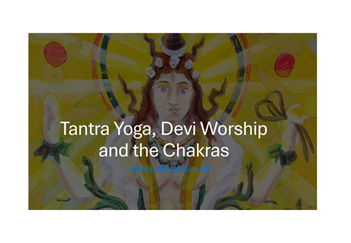Tantra Yoga, Devi Worship and the Chakras
Swami Sivananda in his book Tantra Yoga, Nada Yoga and Kriya Yoga says “Tantra Yoga lays special emphasis on the development of the powers latent in the six Chakras, from Muladhara to Ajna” as a manifestation of Devi’s glory.
 This reflect what I wrote in my previous Blog on Tantra Yoga (and the 3 Bodies) as the practice around our internal energies, through our three bodies, to bring about liberation, and Tantra Yoga and the Wisdom Goddesses around letting go through worship. In this Blog I don’t wish to focus on the three bodies, but rather the aspect of Devi worship; Shakti, the divine mother, the array of other names for the goddesses, the energies of the universe.
This reflect what I wrote in my previous Blog on Tantra Yoga (and the 3 Bodies) as the practice around our internal energies, through our three bodies, to bring about liberation, and Tantra Yoga and the Wisdom Goddesses around letting go through worship. In this Blog I don’t wish to focus on the three bodies, but rather the aspect of Devi worship; Shakti, the divine mother, the array of other names for the goddesses, the energies of the universe.
Swami Sivenanda says “No one can free himself from the thraldom of the mind and matter without Mother’s grace.”
In Shakti philosophy Siva may be omnipresent, pure consciousness, but Siva is also inactive. It is Shakti that is dynamic. It is Shakti that is endowed with Iccha (will), Janana (Knowledge) and Kriya (action). However, this division makes it sound as thought Siva and Shakti are separate. This is to anthropomorphosis Siva Shakti. But as consciousness energy they are one.
Indeed, to further the anthropomorphism, the very creation, preservation and destruction, the functions of Brahma, Vishnu and Siva are only possible due to the energy of Shakti. Shakti is the power behind the gods. And in the guise of Kundalini she leads the individual Soul from chakra to chakra, bringing about liberation.
This is an important point, as it makes clear that Shaktism is not mere theory or philosophy, but a prescribed system (Yoga) we work through for the specific reason of arousing the kundalini to unite with Siva in Sahasrara. When we talk of uniting Siva Shakti though we invariably mistakenly think this is a sexual union (Maithuna) but it is in fact an energetic union that takes place during samadhi.
Swami Sivananda tells us that the great work Ananda Lahari (Tantrik Text) deals specifically with “the Kundalini Yoga and the Chakras” of two kinds. The external and the internal. The external is less evolved and consists of rituals and ceremonies. Here the ‘union’ as energetic doesn’t have the selling power of a physical sexual union, which itself indicates an approach that is based more on the lower chakras (of survival and pleasure) than the heart chakra (of openness and humility).
The internal, involves neither rituals nor ceremonies but an energetic approach to taking kundalini up through the various chakras to Sahasrara through worship. Here we become one with that which is worshipped; the meditator and the meditated become one.
“The devotee of Devi attains realisation of oneness with Devi through intense Upasana or worship.”
This is the true meaning of union.
Bringing it all together
Tantra Yoga, in its Shakti form, works to develop the powers latent in the chakras through the practice of worship, shifting over time from external to internal practices as we progress up the chakras from the lower survival and pleasure orientation to a heart centred approach of love and humility; from and anthropomorphic outlook to an energetic realisation that allows for union and oneness.
Connect on Twitter / Instagram / Facebook
See my Yoga and Tantra related Videos on Vimeo
Message me direct if you are interested in yoga, therapeutic yoga, kundalini tantra yoga, tantra practices, trauma-informed coaching, spiritual coach, gay coach, mindfulness and behavioural coaching, Reiki or stress management robert.pinktantra@gmail.com
See my personal development / personality profiling book DISCover the Power of You published through John Hunt Publishing Ltd, 2017. ISBN: 978-1-78535-591-2
And for those who enjoy historical fiction, stories of underrepresented life’s, see my first novel Fermented Spirits published through Austin Macauley Publishers, 2022. ISBN-13: 978-1398437159